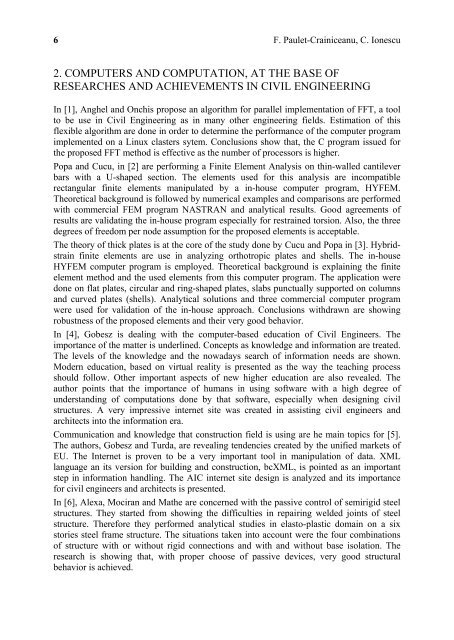âComputational Civil Engineering - "Intersections" International Journal
âComputational Civil Engineering - "Intersections" International Journal
âComputational Civil Engineering - "Intersections" International Journal
Create successful ePaper yourself
Turn your PDF publications into a flip-book with our unique Google optimized e-Paper software.
6 F. Paulet-Crainiceanu, C. Ionescu2. COMPUTERS AND COMPUTATION, AT THE BASE OFRESEARCHES AND ACHIEVEMENTS IN CIVIL ENGINEERINGIn [1], Anghel and Onchis propose an algorithm for parallel implementation of FFT, a toolto be use in <strong>Civil</strong> <strong>Engineering</strong> as in many other engineering fields. Estimation of thisflexible algorithm are done in order to determine the performance of the computer programimplemented on a Linux clasters sytem. Conclusions show that, the C program issued forthe proposed FFT method is effective as the number of processors is higher.Popa and Cucu, in [2] are performing a Finite Element Analysis on thin-walled cantileverbars with a U-shaped section. The elements used for this analysis are incompatiblerectangular finite elements manipulated by a in-house computer program, HYFEM.Theoretical background is followed by numerical examples and comparisons are performedwith commercial FEM program NASTRAN and analytical results. Good agreements ofresults are validating the in-house program especially for restrained torsion. Also, the threedegrees of freedom per node assumption for the proposed elements is acceptable.The theory of thick plates is at the core of the study done by Cucu and Popa in [3]. Hybridstrainfinite elements are use in analyzing orthotropic plates and shells. The in-houseHYFEM computer program is employed. Theoretical background is explaining the finiteelement method and the used elements from this computer program. The application weredone on flat plates, circular and ring-shaped plates, slabs punctually supported on columnsand curved plates (shells). Analytical solutions and three commercial computer programwere used for validation of the in-house approach. Conclusions withdrawn are showingrobustness of the proposed elements and their very good behavior.In [4], Gobesz is dealing with the computer-based education of <strong>Civil</strong> Engineers. Theimportance of the matter is underlined. Concepts as knowledge and information are treated.The levels of the knowledge and the nowadays search of information needs are shown.Modern education, based on virtual reality is presented as the way the teaching processshould follow. Other important aspects of new higher education are also revealed. Theauthor points that the importance of humans in using software with a high degree ofunderstanding of computations done by that software, especially when designing civilstructures. A very impressive internet site was created in assisting civil engineers andarchitects into the information era.Communication and knowledge that construction field is using are he main topics for [5].The authors, Gobesz and Turda, are revealing tendencies created by the unified markets ofEU. The Internet is proven to be a very important tool in manipulation of data. XMLlanguage an its version for building and construction, bcXML, is pointed as an importantstep in information handling. The AIC internet site design is analyzed and its importancefor civil engineers and architects is presented.In [6], Alexa, Mociran and Mathe are concerned with the passive control of semirigid steelstructures. They started from showing the difficulties in repairing welded joints of steelstructure. Therefore they performed analytical studies in elasto-plastic domain on a sixstories steel frame structure. The situations taken into account were the four combinationsof structure with or without rigid connections and with and without base isolation. Theresearch is showing that, with proper choose of passive devices, very good structuralbehavior is achieved.













